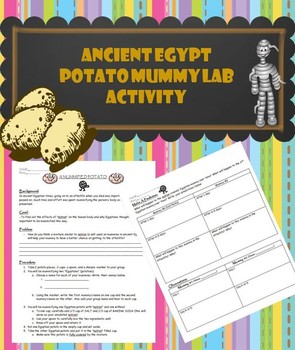Ancient Egypt Potato Mummy Lab Activity
Miss Middle School Teacher
740 Followers
Grade Levels
4th - 8th, Homeschool
Subjects
Resource Type
Formats Included
- PDF
Pages
4 pages
Miss Middle School Teacher
740 Followers
What educators are saying
I used this in a STEM summer camp along with an activity for building pyramids with toothpicks. There is a delayed gratification here as the kids found it more interesting to make observations of their potato/apple slices than they did in making the powder.
We are doing the experiment right now and I can't wait to see the results! My students are so invested and cannot wait to see what will happen! For reasons I won't disclose, I chose to teach Egypt rather than Greece which we normally do, so this was perfect to accentuate our unit!
Description
Ancient Egypt Potato Mummy Lab Activity by Miss Middle School Teacher
This is a great lab to use in tandem with a lesson on ancient Egyptian mummification, as an introduction to the mummification process, or as an extension activity for students needing enrichment opportunities. The ancient Egyptians used a salt-like substance called natron during the mummification process in order to help preserve the bodies. Salts tend to absorb liquids, preventing bacteria and mold from breaking down the body. This lab is meant to help students understand and observe the effects of natron using potatoes and baking soda/salt. Have students follow the steps in the “Procedure” section of the lab. Guide them through predictions, observations, and lead a discussion at the end using the conclusion questions as a vehicle to do so.
This truly is a great lab to promote critical thinking, especially because the natron mummies often look less like the original potato after 4-5 days than the ones not in natron. Since the goal of mummification was for the soul of the Egyptian to recognize the body, students could argue that natron hurts the body more than helps it. Encourage them to think about what the potatoes will look like after 3 months and 3 years, however. Through further investigation, they may realize that moisture promotes the growth of bacteria, molds, and fungi. These microbes eat away at fleshy material and break it down over time so that it’s no longer existent. Help students to see that natron may not make it look better at first, but in the long run it will do wonders for preservation. Leading a discussion using pictures of mummies from ancient Egypt can also be useful in helping students to see the long term effects of natron. Bodies that are well over 2000 years old still have flesh on them! The natron must have helped somehow. You can even have them use evidence from the lab to develop an argument for or against using natron on the mummies. This is a great way to bring in persuasive writing using lab evidence.
TIMING: Observations are made over 5-6 days. Setup and each observation lasts about 15-20 minutes. The final conclusion and discussion day will take about 45 minutes. If you decide to add a persuasive writing activity to go with it, it will take a few days longer.
This is a great lab to use in tandem with a lesson on ancient Egyptian mummification, as an introduction to the mummification process, or as an extension activity for students needing enrichment opportunities. The ancient Egyptians used a salt-like substance called natron during the mummification process in order to help preserve the bodies. Salts tend to absorb liquids, preventing bacteria and mold from breaking down the body. This lab is meant to help students understand and observe the effects of natron using potatoes and baking soda/salt. Have students follow the steps in the “Procedure” section of the lab. Guide them through predictions, observations, and lead a discussion at the end using the conclusion questions as a vehicle to do so.
This truly is a great lab to promote critical thinking, especially because the natron mummies often look less like the original potato after 4-5 days than the ones not in natron. Since the goal of mummification was for the soul of the Egyptian to recognize the body, students could argue that natron hurts the body more than helps it. Encourage them to think about what the potatoes will look like after 3 months and 3 years, however. Through further investigation, they may realize that moisture promotes the growth of bacteria, molds, and fungi. These microbes eat away at fleshy material and break it down over time so that it’s no longer existent. Help students to see that natron may not make it look better at first, but in the long run it will do wonders for preservation. Leading a discussion using pictures of mummies from ancient Egypt can also be useful in helping students to see the long term effects of natron. Bodies that are well over 2000 years old still have flesh on them! The natron must have helped somehow. You can even have them use evidence from the lab to develop an argument for or against using natron on the mummies. This is a great way to bring in persuasive writing using lab evidence.
TIMING: Observations are made over 5-6 days. Setup and each observation lasts about 15-20 minutes. The final conclusion and discussion day will take about 45 minutes. If you decide to add a persuasive writing activity to go with it, it will take a few days longer.
Total Pages
4 pages
Answer Key
N/A
Teaching Duration
N/A
Report this resource to TPT
Reported resources will be reviewed by our team. Report this resource to let us know if this resource violates TPT’s content guidelines.





